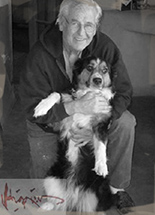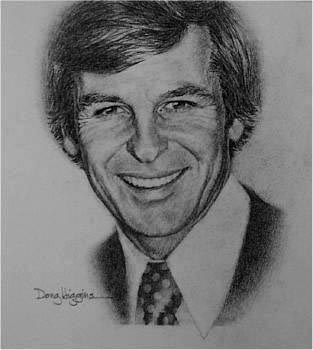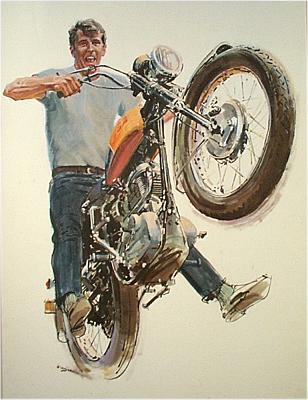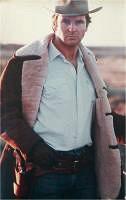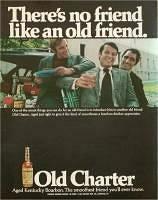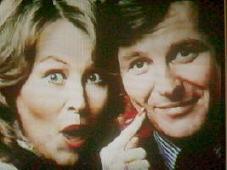Art school & acting
After studying figure drawing and painting at The Frank Reilly School of Art and the Art Students League of New York, Doug Higgins’ art career was sidestepped by more than a decade of acting on stage, screen and television. In 1980 after leaving the television Soap Opera “As the World Turns” he began his professional career as an artist.
ACTING
YouTube clip of “As The World Turns”, Bennett (Doug Higgins), Dr. Bickford and Lisa, November 28, 1979
I liked my early school years well enough but never applied myself. My free time was spent raising hell, pigeons and small animals, as well as shooting pool and working at every menial job I could find. The police put me on probation a few times and frightened my mother with predictions of jail time. I was held back in the seventh grade for truancy and bad grades (Straight A’s in summer school). I spilled motorcycles sometimes at high speeds, was shot at while climbing a barn to catch pigeons, fell while unconscious from the top of a train after being electrocuted and was thrown from a car I crashed one drunken night in Patterson, New Jersey. For three summers while attending an Art School I held a job in Port Newark loading lumber trucks for the Weyerhauser Lumber Company. One morning a loader driver lost control, struck the railroad tracks and turned over in the Timber Alley where I was working, barely missing me and crushing himself to death. Despite these and other perilous experiences I managed to survive in tact, changed course and became a successful artist. The following is the story of the learning that made such a thing possible.
– Doug Higgins
“A thing worth doing is worth doing well,” my mother used to say. With clichés such as this and by example, she managed to instill a work ethic in me and a degree of self discipline. Necessity was her ally. I watched her paint, sat for my portrait (not a pleasant experience), attended museums and galleries with her in New York, and was surrounded by paintings in our home. I suppose we were living in poverty but, despite this, her portrait ability and love of art, as well as having been raised in a prominent Boston family, gave my mother a positive sense of herself which extended to me. For no rational reason that I could detect she believed I would do well in life. I suspect that this unwavering and, at the time, seemingly unwarranted belief produced a positive result. My memories from those early years are not unpleasant.
I was born Eugene Douglas Higgins, in September of 1939. My father, Eugene Francis Higgins, passed away when I was three years old leaving my mother, a half-sister, our Scottie and me destitute. My mother, Grace Louise Higgins, nee Whalley, and her first husband, Samuel Burtis Baker, were both Boston School artists. Burt Baker was described to me by my mother as a man leading the ultimate life, the life of an artist. I met him in my early teens and he, and my mother’s stories about him, had a great influence on me. It was a foregone conclusion that I would become an artist as well. Manifest destiny. (For information on Baker see American Art Review magazine, Feb-Mar 1994, pp. 110-115.)
When I was eleven or twelve years old, I have a clear memory of walking along Valley Road near my grammar school in Montclair, New Jersey and thinking, “There are beautiful paintings inside me, all I have to do is find a way to get them out.” I took art classes in high school, attended college as an art major (after a required extra year of high school) and quit because all they taught was modern art. The following three years, I later came to realize, were mostly wasted at an inadequate art school in Newark, New Jersey.
After the Army and in my twenties, I was working as a commercial artist at the Prudential Insurance Company in the Public Relations and Advertising Department. The director of my department was Henry Gasser NA, a well-known watercolor artist, and when I told him I wanted to continue my art studies he suggested the Frank Reilly School of Art. When I was applying to get into Mr. Reilly’s school, I showed him the pencil drawing of the boxers above. He glanced at it and said, “Yes, I can help you with that”.
In addition to teaching, Frank Joseph Reilly was a fine artist, illustrator, muralist, syndicated columnist, after dinner speaker, film producer (on Dean Cornwell, James Montgomery Flagg etc.) and lecturer. He was respected not only for the high quality of his work as an artist and teacher but for the professional achievements of his students. While he was teaching at the Art Students League, (29 years), there was up to a three year waiting list for his classes and his formal lectures were standing room only. He had studied with George B. Bridgman for drawing and was his monitor, Frank Vincent Du Mond for painting and with his friend Dean Cornwell for murals (He later executed a sixty three foot wide mural at the Bronx High School of Science).Mr. Reilly had developed the skill of disaggregating the complexities of realism and communicating to his students clearly and specifically.
I commuted to Manhattan five nights a week to attend classes at his night school and had finally found a teacher. For the first time in my life I became a dedicated student and came to believe that if I learned what he was teaching I would have a chance at a career in art. It was an honor and a great help financially when he appointed me monitor, first in the drawing and later in the painting class. A monitor paid no tuition, called the poses, kept order, started off new students and locked up the school.
I never missed a night in the over four years I was with him up until his untimely death. The night before he went into the hospital he said, “Well, good night Hig.” and I had to help him find his coat. I stood in the darkened hallway and watched him slowly walk to the elevator and disappear inside. I never saw him again and the only testaments I can offer are the published books I wrote describing his teaching and the career he gave me which I continue to love.
While studying with Mr. Reilly, which is what we all called him, my ambition was to become an illustrator, nearly the only career open to a representational artist in New York at the time. In order to study original illustrations, I would attend exhibitions at the Society of Illustrators where the highest quality current work (some by former Reilly students) could be seen as well as a permanent collection. The best illustrators were skilled in the basic drawing and painting methods I was in the process of learning. These awe-inspiring skills, so painstakingly developed by artists down through the centuries, had been discarded by the various modern art, ‘Isms-of-the-week.’
“Only an auctioneer should admire all schools of art.” – Oscar Wilde
In order to earn a living after moving to New York, toward the end of art school, I worked as a fashion model with the Stewart Men Model Agency who sent me on “go sees” to photographers but also for television commercials. After a year or so, and a commercial class, I found work on television as an actor and an on-camera presenter. I stopped modeling and concentrated on commercials. During my time as an actor, I appeared in over two hundred of them including my first trip to Europe for a series of Chevrolet commercials and print ads.
During one of the European locations we were staying at the Eisenhut (Iron hat) in the picturesque German town of Rothenburg pictured in the ad on the left. One of many locations which included Nice, France, Garmish, Switzerlandand and Tegernsee, Austria. The series of commercials we shot also called for high performance driving which I enjoy.
My acting coach was Wynn Handman, director of the American Place Theater. His teaching ability was inspiring and I again became a dedicated student. I was cast in five plays at his theater, one of which was taped for the Theater in America series on PBS. I was willingly seduced away from a career in painting for over twelve years.
One of the main reasons I was so drawn to acting was that as a boy I had an almost insurmountable fear of speaking before groups. I never defeated the fear but learned to control it and use it as a source of energy. Finding I had a talent for acting and winning numerous jobs over intense competition increased my self-confidence immeasurably.
I continued to paint when I wasn’t working or seeking work. In 1980, upon leaving the Soap Opera, As the World Turns, after over a hundred episodes I made the decision to return to painting and begin a career as a landscape painter. My wife and I moved to Santa Fe, New Mexico where painting opportunities were in abundance and realism was more in demand than in the modern art climate of New York. Cecily Hughes and I had been married in Santa Fe and a cousin of hers, Pat Pellham, was selling art for a gallery in the downtown area. I had begun showing my work with Pat while I was still an actor but the gallery owner asked me to leave. When Pat opened her own gallery, the Pellham Art Gallery, just off the plaza in Santa Fe, my much delayed fine art career was launched.
Cecily, who had been an executive with Perrier in New York, was working as a cocktail waitress and her income and my dwindling savings were barely keeping us afloat until a bookie produced a wad of hundreds from his pocket and bought a painting. Cecily and I stayed together for six years, then went our separate ways but remain friends.
No doubt my acting training had a beneficial effect on my painting . For instance, actors become proficient in mental preparation so that the transition from backstage to on-stage is seamless. Painting a picture in my mind before actually picking up a brush is a similar technique. I employ over arching ideas at times for my painting, a device used to develop a theatrical character and for grasping the sub-text of a play. For instance, in Venice, Italy, I was attracted to the feeling of the narrow streets with their filtered, indirect light and mysterious forms moving in and out of shadows and sought out motives consistent with this idea. And in Gloucester, MA, the crowded harbors and the complexity of a variety of intricate forms caught my attention.
Wynn Handman, my acting coach, once said to me…”Surprise me. If you don’t surprise me, what do I need with you, I can read the text.” Using painting tools, for instance, in such a way that the results are not completely predictable can contain the surprise element. In general, any sensible experiment or change of any kind, has surprise potential.
The best definition of acting I know may also be accurately applied to painting… ‘living truthfully in imaginary circumstances.’
Much of what I studied as an acting student; psychology, sociology, poetry, the works of the great playwrights and the writings of the giants of the field, has positively affected my painting. Although I’m not always able to identify specifically the results produced by these various studies, in general terms it may be fairly stated that any art will benefit from the investigation of related fields.
Hemingway said that Cezanne’s paintings taught him how to write and Van Gogh wrote to his brother, Theo, that he wished to, “Signify hope by some bright star.”, a poetic allusion.
